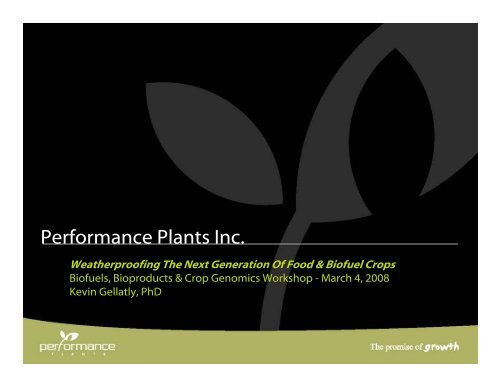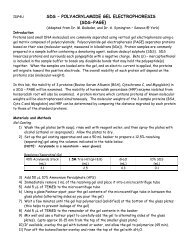Weatherproofing the Next Generation Of Food & Biofuel Crops
Weatherproofing the Next Generation Of Food & Biofuel Crops
Weatherproofing the Next Generation Of Food & Biofuel Crops
Create successful ePaper yourself
Turn your PDF publications into a flip-book with our unique Google optimized e-Paper software.
Performance Plants Inc.<strong>Wea<strong>the</strong>rproofing</strong> The <strong>Next</strong> <strong>Generation</strong> <strong>Of</strong> <strong>Food</strong> & <strong>Biofuel</strong> <strong>Crops</strong><strong>Biofuel</strong>s, Bioproducts & Crop Genomics Workshop - March 4, 2008Kevin Gellatly, PhD
Performance Plants Inc. (PPI)• 11 year history of developing agronomicallyimportant plant traits• Facilities in Kingston and Saskatoon, Canada• Staff of 38 (Strong Physiology & Agronomy Groups)• Completed largest Ag-Biotech private equityfinancing in Canadian history - 2006• License agreements in place(Scotts, Stine, Syngenta and o<strong>the</strong>rs)
Performance Plants is Located in Kingston,Ontario• State of <strong>the</strong> art 18,000 ft 2biotech facility• 4,400 ft 2 GrowthChambers• 7,800 ft 2 Laboratories700 Gardiner’s Road, Kingston ON K7M 3X9
Kingston West Centre For Innovation
PPI Industrial Research Chair• NSERC Industrial Research Chair• Peter McCourt – U of Toronto (YPT )• $1 million annual budget• $6.8 million CFI grantU of T Greenhouses
PPI’s R&D PipelineFeed PipelineTrait conceptsMutant GenesPPI PipelineCommercializationSeed and ProductSales & DistributionDiscoveryBioinformaticsModel Proof ofConceptCropDevelopmentField Proof ofConceptCommercialDevelopmentEfficacy in EliteGermplasm
Demand for New Biotech Traits• 3 X crop production will be required• Increased global food demands• <strong>Biofuel</strong>s• But, crop yield increases will be difficult• Arable land NOT increasing• Depletion of water for irrigation• Increasing temperature
Energy <strong>Crops</strong> – Massive Potential• “Growing an energycrop on 3.2% of <strong>the</strong>earth's land masswould satisfy allmankind’s energyneeds”Chris Somerville (2006)
Biomass to Supply <strong>the</strong> Bio-refineryEconomyProcessOutcomesInputFermentationCellulosic ethanolBiomassenergy cropsCo-firingCoal displacementElectricityGasificationBio-OilBio-oilPyrolysisCo-products
US Cellulosic Ethanol Mandate CreatesOpportunity2022 fuel projectionTotal=225 B GalCurrent Potentialnon-starchEthanol Sources14.410.24Waste18921.611.36Purpose Grown <strong>Crops</strong>PPI opportunity: capacity gap as high as 11.36 Bgal
Cost Improvements for Cellulosic EthanolNREL presentation
High Yield Reduces Production Costs
High Yield Reduces Transportation Costs15 t/ac (8 miles)5 t/ac (14 miles)10 t/ac (10 miles)50 Mgal facility, 25% land use
PPI Solutions• Deliver huge, wea<strong>the</strong>rproof yields onmarginal agricultural land• Dedicated energy feedstocks optimizedfor industrial end users• Economically viable for both farmers andindustry
Yield Protection Technology –YPT WET ECT BET HEAT YPT KingstonTechnologyEvaluationSaskatoonCropDevelopmentPPI/PartnerProductDevelopment
Impact of Drought on Cob Development500 kernels per ear 15 kernels per earBoyer et al. (2004) Journal of Experimental Botany 55:2385-2394
Drought Tolerance Mutant era17 days of ofdroughtParent mutant
YPT Mechanism: era1 Mutant MakesStomata More Sensitive to ABA
A Molecular Switch Protects <strong>the</strong> PlantYPT Dark bands indicate <strong>the</strong>trait is protecting <strong>the</strong> plantfrom droughtParent
YPT Helps <strong>Crops</strong> Survive Drought
Canola Drought Stress Field Trial6 reps/plotLESS IRRIGATION1 irrigation duringJuly floweringMORE IRRIGATION2 irrigations duringJuly flowering
YPT Canola Outperforms Controls13012512011511010510095908580Seed yield (% of Control)ControlYPT2002 6.3 2003 6.4 2003 3.4 2004 7.5 5.8 2004 7.9 2004
Effect of Available Water During Floweringon YPT Canola YieldYPT Seed Yield (% Null)12011511010510095R 2 = 0.90 20 40 60 80 100Total Rainfall at Flowering Period at 6 Sites (mm)
YPT Protects Against WiltingControlYPT
YPT Mechanism Demonstrated Using ABAAnalogues in Store-bought Tomato PlantsBeforeAbrams, PBIAfterDroughtMimicking YPT actionusing an ABA analogue thatcauses hypersensitivity
YPT Licenses & Joint Ventures• Corn• Soybeans• Turf & ornamentals• Rice• Cotton
YPT Peer-Reviewed Scientific Article
Plants for Drought Affected AfricaSept 2007 –PerformancePlants/ Africa HarvestBiotech Foundation Int’l(Kenya) announced analliance to develop newcrops for Africa“Africa cannot afford to beexcluded from <strong>the</strong> BiotechRevolution”Dr. Florence Wambugu(President Africa Harvest)
O<strong>the</strong>r Technologies being Developed
WET – Improved Water Use EfficientlyMaintained YieldWET MutantReduced YieldWild-Type
Efficient Water Use Increases YieldYield After Drought Stress (% of Parent)160%140%120%100%80%60%40%ControlWET
Heat Reduces Yield in CanolaAborted SeedDevelopment29°C22°C 22°C 29°C
Canola HEAT Preserves YieldSeed Yield (% of D3 Control)13012011010090807060ControlHEAT3 5 7 9Days at daytime 29°C
BET– Plants With 2-4 X More BiomassWild-Type BET
PPI Yield Traits Reduce Production CostBETYPTWET
PPI Cell Wall Modification ProgramPlants more easily converted to fermentable sugarsLess: time, energy, waste & cost
Partnering With Biomass Crop Ownersand Industrial End UsersHempMiscanthusSwitchgrassSorghumSugarcane Tropical maize Willow Poplar
Thank YouVisit us at: www.performanceplants.com






